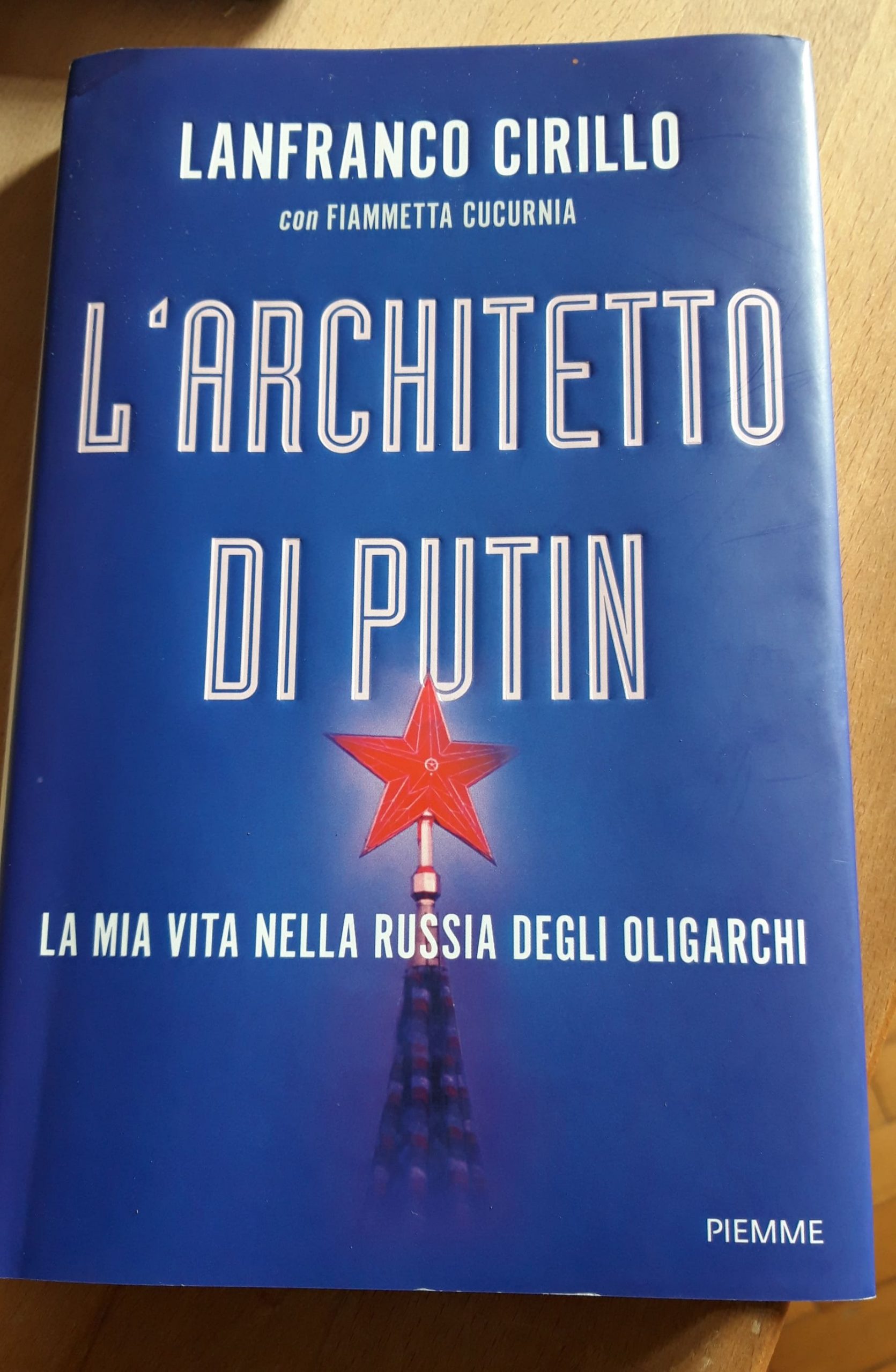
- 29/02/2024
Caio Mussolini
- in Culture & Costume
- 0Comments
This is the title of a book that immediately intrigued me, and which I read practically without interruption. An incredible story of sacrifices and successes of an Italian, an emigrant like many others, who starting from a small town in Lombardy became one of the most important entrepreneurs in Russia, to the point of being nicknamed Putin’s Architect (even though he never worked directly for the Russian President).As a fan of immigration issues, I have always maintained that one of the things that all people of all levels who decide to leave their country for various reasons have in common is the desire to get involved, the desire to work, to dare. It’s a drive to do something that one has within oneself, and that’s what Lanfranco Cirillo, born in 1959, did when he decided to emigrate to Russia.
A multifaceted man with a thousand interests and various passions, starting with travel with explorations in Antarctica and the Arctic, in Africa, Asia, America. Passionate about aeronautics, he decided at the age of twenty to obtain a license to fly airplanes in Texas and years later, already as an established businessman in order to be able to move more quickly and independently, to obtain a helicopter license, following courses at the very strict schools Russian flights.
An eyewitness to the great transformations of post-Soviet Russia, he arrived in Moscow almost by chance at the end of 1993. It was once said that emigrants left with cardboard suitcases. In his case he left with a trolley full of brochures, samples and catalogs of furniture from Brianza, a few lire in his pocket and without even knowing a word of Russian.
In his book he recounts the difficulties encountered at the beginning of his adventure, in a reality profoundly different from the Western world to which he was accustomed, and how little by little, working tirelessly with the professionalism and seriousness that still distinguishes him today, he began to gain the trust of the first clients who were happy to take advantage of his experience. Keeping up with this new emerging social class in Russia, the so-called oligarchs, was not easy: problems of understanding, difficult language, projects that changed 100 times, requests bordering on the impossible (there are those who wanted a real furnished war submarine in the garden or a swimming pool that had to have a lifting bottom…) and above all discussing with the wives, who demanded increasingly more falorous projects. But hard work bears fruit, and the Lombard architect was increasingly better known and more and more in demand. A growing number of Russian families wanted to entrust him with jobs: houses, villas, palaces, resorts. Everyone was looking for the quality and seriousness that only he was able to offer. The company opened a few years after his arrival – the Masterskaja – grew, and young architects began to arrive (in 2005 there were over 100 architects working in his studio in Moscow) and many specialized workers from Italy to guarantee the quality and finishes agreed in the very long specifications. Every contractual commitment made had to be respected down to the smallest detail, and without cheating on anything: if lapis lazuli, mother-of-pearl toilets or Egyptian onyx were foreseen in a bathroom, so it would have been. No shortcuts were allowed.
After a few years, there was so much work that he could afford to create waiting lists and charge 3,000 euros per hour for a meeting with a client, to optimize and shorten the time.
Thanks to his work, for years trucks with 3 or 4 containers full of materials, furniture and furnishings left Italy for Russia. Cirillo offered something unique that the rich oligarchs greatly appreciated: a “turnkey” project complete with everything and taken care of down to the smallest detail. His life was a continuous travel, one day called to inspect a house in Monte Carlo and the following day an office in London, a house in Miami or to view a mega-yacht in Germany for which he had to design the interiors with his unique style.
The entrepreneur, who left with his trolley full of brochures, after having taught himself the language had become in just a few years an ambassador of Made in Italy in Russia, managing to work for 44 billionaires on the “Forbes” list. The relationships with the Russians were not just work-related: thanks to his empathy and ability to listen, almost like a “shaman”, he had become a prominent personality, invited to events, parties and dinners every evening, transforming this entrepreneur into a “bridge ” not only economic, but above all cultural between the two countries. After 15 years living in the country, in 2013, he decided to write to President Putin and obtained Russian citizenship. He is the first Italian to have this recognition since the fall of the Soviet Union.
A chapter of the book is dedicated to his daughter Elisabetta. She was a cheerful girl full of interests that she often shared with her father (starting from his passion for travel), and who had also worked abroad like many young people interested in gaining expatriate experiences. He then participated in his father’s work activities, accompanying him on construction sites scattered throughout Russia, holding positions with ever greater responsibility until the discovery of a terrible illness, often still impossible to cure. Having her visited in the best hospitals in the world, staying close to her and accompanying her on her therapeutic journey both in Italy and abroad, was unfortunately not enough. Reading the pages of the book dedicated to her, it is movingly clear how much her father loved her, and the excruciating pain that her tragic death at a very young age in 2019 caused in this man.
But then something happens that will change his life as a successful entrepreneur and free citizen. Following a letter sent to the then President Medvedv by an entrepreneur called Kolesnikov, Aleksj Navalnyi’s anti-corruption foundation threw itself headlong into the deal concerning a residence in Gelendzik and in 2010 denounced alleged corruption schemes in the country. A year later, in a report by the same foundation, his name was mentioned and some photos of him were published, erroneously defining him as the designer of the building whose ownership had been erroneously attributed to Putin. Despite Cirillo’s very reserved character, he reluctantly becomes a public figure, whom everyone talked about without even knowing him. Having nothing to hide he also began to give interviews to the media to tell the truth about him.
In the meantime, relations between the USA, Europe and Russia began to degenerate and being an Italian entrepreneur working in Russia had become a sin, a new original sin that marked people for life, regardless of all the successes and works created as an emigrant. in more than 20 years of hard work. In February 2021, our compatriot’s life would have been turned upside down a second time with incredible judicial consequences that continue to this day. While he was in the family home in Roncadelle, at 5 in the morning a large group of financiers broke into the house with a search warrant. The accusation was that of having evaded taxes from 2013 to 2019, i.e. during the period of his daughter’s illness, with the bizarre theory that Cirillo did not really live in Russia. It all seemed like a Kafkaesque comedy, a man who works permanently abroad where he has built a fortune thanks to his continued presence – fundamental – for the success of the company, how could he live in Italy? How could he be accused of “foreign dressing”? For him it was a clear mistake.
This limbo in Italy continued until March 2022, when he took a plane to go to Dubai and subsequently returned to Russia a few weeks after the start of the war. In the meantime, after resuming his work activities, his contacts with lawyers in Italy continued to collect the information and evidence necessary to demonstrate the unfoundedness of the accusations through a detailed defense brief sent to the prosecutor’s office 2 months later.
Convinced – naively – that the matter had finally been clarified in some way, in August Cirillo instead received a phone call where he was informed by a family member that the Finance Department had shown up at the house again and had seized everything: car, jewels, valuables , money. But the surprises for our fellow citizen were not over: an international arrest warrant had also been issued through Interpol. And with the highest level of alert, a “red notice”, as if he were a murderer, a terrorist or a dangerous mafioso. Like Osama Bin Laden or Matteo Messina Denaro to understand…
The recurring question in his head was: “But what have I done? How can you put in prison a person who has not killed, who has never had a debt in his life, with an incomprehensible accusation of foreign dressing and self-laundering, that is, having transferred part of my earnings to Russia from Russian accounts to Italian ones?”. The Lombard emigrant who arrived in Russia 30 years ago, who managed to build an economic empire after years of sacrifices, concludes his book with some bitter considerations on the ongoing war and the inevitable future consequences in the relations between the two countries. Relationships that had always been excellent, when we were admired and respected and always welcome. Where Italian style, culture, music, good taste and class were appreciated more than those of any other country in the world.
And I too would like to add a final consideration thinking about the many Italians who have emigrated abroad and have worked hard to improve their position, with enormous sacrifices that are often never recognized at home. I wonder what the point is to subject a successful Italian to this type of harassment, an emigrant who has contributed from afar to the economic development of his country, of Made in Italy, who has created wealth for many Italian companies and workers, as well as having made the best known and appreciated of Italy in distant nations. Does it make sense for the state to destroy a person’s life like that?
Caio Mussolini
For those wishing to delve deeper and learn more about the exciting life and story of Lanfranco Cirillo, I suggest purchasing the book “Putin’s Architect – My life in the Russia of the oligarchs”, published for Piemme by Mondadori Libri S.p.A. and also available online.


